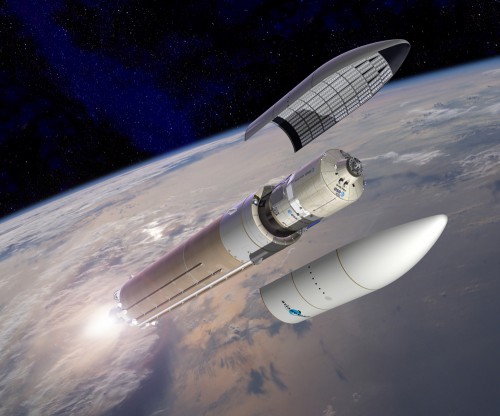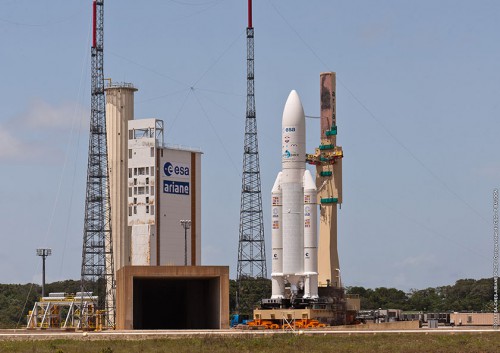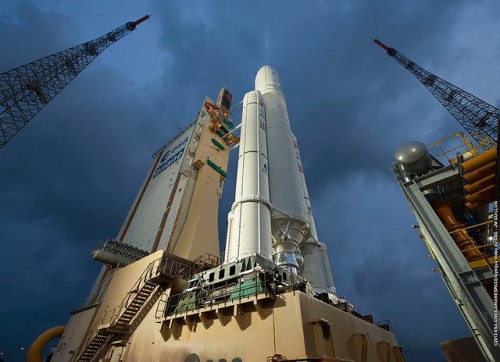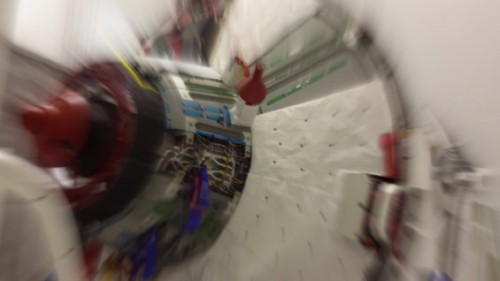
Europe’s mammoth Ariane 5 rocket has successfully boosted the fourth Automated Transfer Vehicle (ATV-4)—named in honor of German-born physicist Albert Einstein—into orbit, en-route for a cargo delivery voyage to the International Space Station. Liftoff of Flight VA-213 took place from the ELA-3 complex at the Guiana Space Centre in Kourou, French Guiana, at 6:52 p.m. local time (10:52 p.m. UTC) Wednesday. A little over an hour later, ATV-4 separated from the final stage of the Ariane and is presently in independent flight, following a 10-day rendezvous profile, ahead of docking at the orbital outpost on 15 June.
Today’s flight marks the second-to-last ATV mission, following a decision by the European Space Agency (ESA) last year to build no more vehicles past ATV-5. However, in January 2013, the prospects for the heavy-lift cargo craft brightened in the form of a possible future role in the Orion Service Module for NASA’s Beyond Earth Orbit aspirations. As if to demonstrate ESA’s can-do spirit, the 44,830-pound ATV-4 is the heaviest vehicle ever lofted by an Ariane rocket and is transporting 5,500 pounds of equipment, food, water, fuel, and supplies to the space station’s incumbent Expedition 36 crew. This marks the largest payload of dry cargo ever ferried into space by a European spacecraft.
The booster itself arrived in French Guiana in February, primed for Flight VA-213—the 213th mission by Arianespace’s rocket family since the maiden voyage of its Ariane 1 in December 1979. This was also the 69th voyage of the Ariane 5 variant, which first flew in June 1996. Last month, ATV-4 was installed by crane atop the rocket inside the 295-foot Final Assembly Building (BAF) at the Guiana Space Centre and the full payload was encapsulated within Ariane 5’s bullet-like fairing on 24 May. This relatively late encapsulation allowed for the loading of last-minute cargo items for the ISS delivery mission. “The station’s needs change with every mission and there are always last-minute requests of every kind,” noted ESA in an ATV-4 pre-launch update. “A new Late Cargo Access Means lift will be used to load larger and heavier bags during the last weeks before launch. This allows for greater flexibility when ATV is already on top of its Ariane 5 rocket.”

Rollout of the VA-213 vehicle from the BAF to the ELA-3 (Ensemble de Lancement Ariane) complex took place yesterday (Tuesday). Standing 171 feet tall and weighing almost 1.7 million pounds, the two-stage Ariane 5 represents one of the most powerful launch vehicles in operational service. Since its ill-fated first flight in June 1996, it has supported 69 missions, including today’s launch, of which only four have been classified as total or partial failures. On its very first launch, it succumbed to a control software glitch, which caused it to veer from its intended flight path and the flight termination system destroyed the vehicle. The second mission, in October 1997, fared little better, but suffered a premature shutdown of its core stage and failed to attain orbit. Two others, in July 2001 and December 2002, also underperformed, but Ariane 5 has maintained an unblemished record ever since.
In the final hours before today’s launch, the electrical systems aboard Ariane 5 were checked and at T-4 hours and 50 minutes the lengthy process began to load 260,000 pounds of liquid oxygen and 50,000 pounds of liquid hydrogen into the 100-foot-tall “cryotechnic main stage.” These propellants fed the stage’s French-built Vulcain-2 engine. As the clock ticked closer to launch, Ariane’s propellant tanks were pressurized for flight at T-4 minutes and the vehicle was transferred to internal power. In the final seconds, the on-board systems assumed primary control of all critical functions and the guidance systems were unlocked to flight mode. Ignition of the Vulcain-2 engine and its 300,000 pounds of thrust were followed by the ignition of Ariane 5’s twin side-mounted solid-rocket boosters, each capable of a 1.4-million-pound propulsive yield. At this stage, VA-213 was committed to flight.
Twelve seconds after T-zero, the rocket began a computer-commanded pitch and roll program maneuver, tilting its trajectory toward the northeast and establishing it on the proper flight azimuth for a 51.6-degree-inclined orbit and an altitude of about 150 miles. “It will maintain its attitude,” noted Arianespace in its VA-213 launch kit, “to keep the launcher’s axis parallel to its airspeed vector in order to minimize aerodynamic loads throughout the atmospheric phase of the launch, until the solid boosters are jettisoned.”

Following the departure of the boosters, at T+142 seconds, Ariane 5 continued to climb, under the impulse of its Vulcain-2 core engine. At three and a half minutes, ATV-4’s payload fairing was released. The Vulcain-2 shut down and the core stage was discarded at about nine minutes into the flight. “On this mission, the main stage will fall back into the Atlantic Ocean, off the coast of Portugal,” continued Arianespace. The turn then came for Ariane 5’s second stage, powered by a restartable Aestus engine, with a vacuum thrust of 6,100 pounds. This engine is fueled by unsymmetrical dimethyl hydrazine and nitrogen tetroxide and burned for eight minutes, then shut down and entered a lengthy period of coasting, ahead of its second burn. “Following a ballistic phase, lasting 45 minutes, the upper stage is then reignited to circularize the orbit, directing the ATV, once separated into its targeted final orbit,” concluded the Arianespace launch-plan synopsis. The Aestus’ second burn lasted about 30 seconds.
By now, an hour had elapsed since launch and at T+63 minutes ATV-4 separated from the final stage of the Ariane 5. “Albert Einstein”—or at least a space-going namesake of the great physicist—finally reached the environment about which he had written, studied, and theorized almost a century ago. Ten days of maneuvers now lie ahead of the cargo craft before its scheduled arrival and docking at the aft port of the International Space Station’s Zvezda module on 15 June, carefully watched by Expedition 36 Commander Pavel Vinogradov. It will remain a pressurized component of the expansive outpost until late October, when it is due to be undocked and deorbited. According to NASA’s Expedition 35/36 press kit, the ATV-4 cargo includes drinking water, food, clothes, equipment, and propellant, and the spacecraft is expected to a boost of the space station’s orbit. A test of this capability is scheduled for later in June, ahead of a full-up re-boost on 10 July.

Measuring 34 feet long and 15 feet in diameter, the ATV consists of three main components: an Integrated Cargo Carrier (ICC), which houses its pressurized payloads, together with an Avionics Module for computers, gyroscopes, navigation and control systems, and electrical power and communications facilities, and a Propulsion Module to support rendezvous and docking, as well as periodic “re-boosts” of the ISS orbit. Power comes from four solar arrays, which form an X shape when fully deployed, and have a total electrical yield of 3,800 watts. Unlike Japan’s H-II Transfer Vehicle (HTV), SpaceX’s Dragon, and Orbital Sciences Corp.’s Cygnus, the ATV is not designed to berth at the U.S. segment of the ISS, but at the Russian “end.” Consequently, it is equipped with a Russian-compatible Progress-type docking mechanism.
Since the launch of the first ATV—named for Jules Verne, the 19th-century French science-fiction writer and visionary—back in March 2008, the craft has seen regular service at the space station. ATV-1 spent six months aloft and was undocked and intentionally burned up during re-entry the following September. Next came ATV-2, which paid homage to 17th-century German astronomer Johannes Kepler, and which flew from February-June 2011. Most recently, in March of last year, ATV-3 was launched and bore the name of Italian physicist Edoardo Amaldi. This third craft was deorbited in October 2012. With “Albert Einstein” now picking up the baton, the ATV-4 mission is expected to run for about four months, with undocking planned in late October. Only one further voyage, ATV-5, named for Belgian astronomer Georges Lemaître, is scheduled to take place and will fly in the summer of 2014.
Want to keep up-to-date with all things space? Be sure to “Like” AmericaSpace on Facebook and follow us on Twitter:@AmericaSpace




Very impressive vehicle. It’s sort of a pity that they couldn’t have just added the re-entry capability but perhaps that would have limited the upmass too much. Seems such a waste to lose all that effort though.
Whoops, should have said return (to Earth in one piece for potential reuse) capability. It does, after all, re-enter.